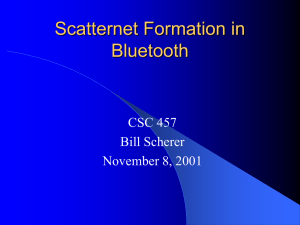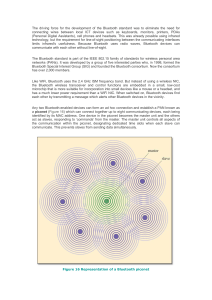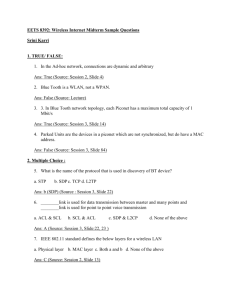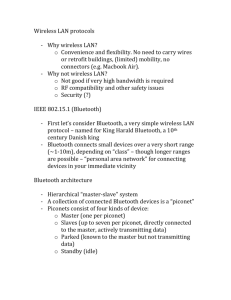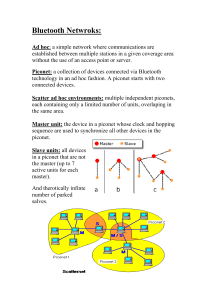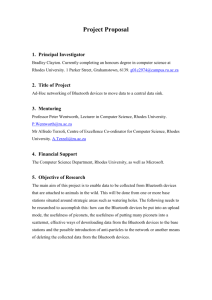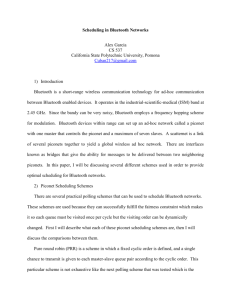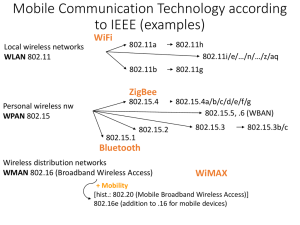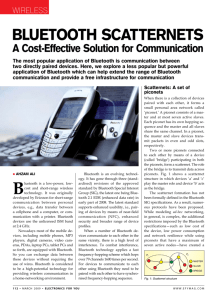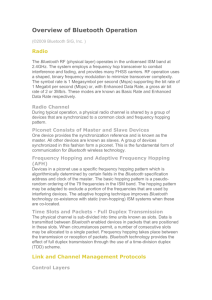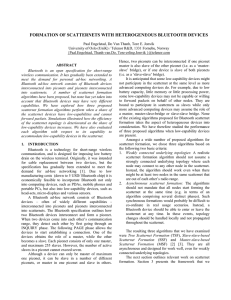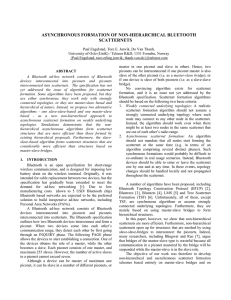Bluenet a New Scatternet Formation Scheme*
advertisement
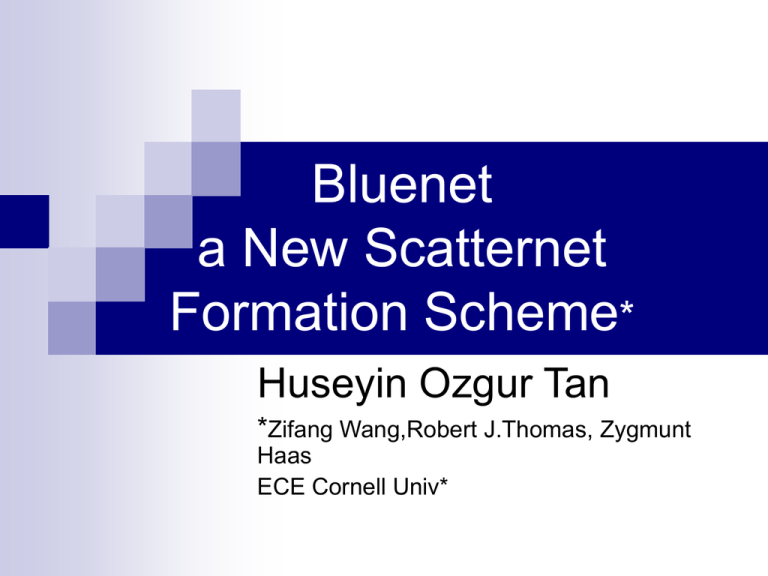
Bluenet a New Scatternet Formation Scheme* Huseyin Ozgur Tan *Zifang Wang,Robert J.Thomas, Zygmunt Haas ECE Cornell Univ* Outline Introduction Bluenet Scheme Evaluation Methods Simulation Environment Simulation Results Introduction Performance issues for scatternet formation Waste of capacity for bridge nodes Resynchronization of radio from one piconet to another Cost of some of network resources to maintain a scatternet Master-Slave relation Tradeoff Decent level of Connectivity Reserving enough network resources Introduction Other scatternet formation schemes At that time a few papers that address this problem The most important one : Bluetree In this paper proposed Bluenet and Bluetree algorithms are compared Bluetree Two modes of formation Blueroot Grown Bluetree Distributed Bluetree All resulting scatternets: spanning tree Adv: spends the least of network resources Disadv: Reliability If one parent node is lost, scatternet becomes disconnected Efficiency All traffic has to traverse the tree in upward and downward direction Bluenet Scheme Background Information Information exchange requires master slave relation Visibility graph Polling and coordinating the slaves Bridge overhead Network consisting of all the units and all the potential links Scatternet is a small fraction of all the potential links Scatternets are a subgraph of visibility graph Intra piconet overhead Try to construct the scatternet while forming master slave relations Switching delay between different piconets Standby -> Inquiry -> Page = master slave relation Bluenet Algorithm Goal: efficient scatternet Reasonable good connectivity but preserves network resources for communications. The network resources should be spread as evenly as possible to prevent bottlenecks 3 Rules Rule 1: Avoid forming further piconets inside a piconet Rule 2: For a bridge node, avoid setting up more than one connections to the same piconet Rule 3: Inside a piconet the master tries to acquire some number of slaves Bluenet Rule 1: Since the traffic is well organized in a piconet can be achieved if the master sends the list of its slaves to all its slaves Rule 2: To avoid excessive bridge overhead for the bridges can be achieved if the units are capable of sending their piconet identity Rule 3: Size of the piconet effects final structure Bluenet Phase I: Initial piconets are formed Phase II: Separate Bluetooth node get connected Phase III: Piconets get connected to form a scatternet Evaluation Methods Average Shortest Path (ASP) Average shortest path length among all 2-node pairs in a Bluetooth network Only related with topology ASP0 = minimal ASP obtained from visibility graph ASPsct = actual ASP of the scatternet being evaluated R = ASPsct /ASP0 Evaluation Methods Maximum Traffic Flows (MTF) Important to learn about the information carrying capacity of network MTF is based on maximum flow problem If The maximum amount of information that can be transmitted per unit time from source node s, to sink node t, without violating the link and node capacity limits. Ford-Fulkerson Algorithm there is multiple sources and sinks problem of maximizing becomes maximum multi-commodity flows. Evaluation Methods Algorithm for approximating MTF A. calculate all maximum flows for all commodities by using Ford-Fulkerson method B. Select the commodity pair with the largest maximum flow; then remove the commodity pair; and decrease the corresponding link capacities C. repeat steps A&B until there is no commodity pair left. The MFT is the sum of the largest maximum flows obtained from each run of b Simulation and Results n, Bluetooth devices are randomly placed Visibility graph is obtained The scatternets are generated by Bluenet and Bluetree Performance is evaluated Simulation Results On ASP 200 scatternet samples are generated Mean ASP Bluenet = 2.08 Bluetree = 2.31 Simulation Results On MTF 6 scatternets are formed for both schemes 6000 randomly generated multicommodities are used for calculation Conclusion Advantages Easily implementable on existing Bluetooth specs Fast topology construction No further information collection Disadvantages All devices are assumed to be turned on simultaneously No mobility support Static nodes Future Work Must be compared with the new scatternet formation methods Especially with Law & Siu’s method Future work can be done on mobility support dynamicity Thanks for patience Questions & Answers
